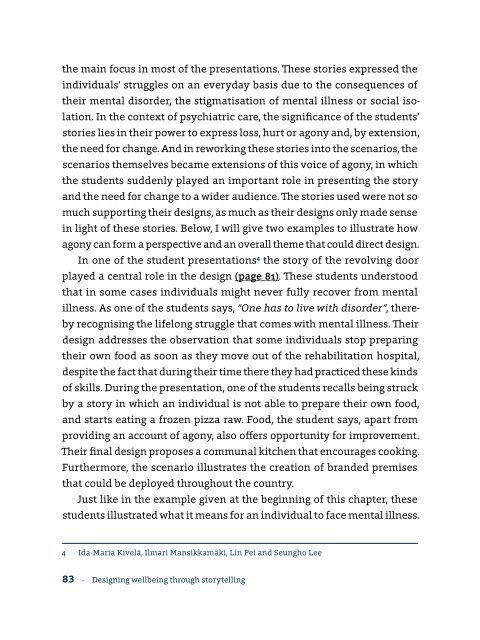Designing for wellbeing
Designing for wellbeing
Designing for wellbeing
Create successful ePaper yourself
Turn your PDF publications into a flip-book with our unique Google optimized e-Paper software.
the main focus in most of the presentations. These stories expressed the<br />
individuals’ struggles on an everyday basis due to the consequences of<br />
their mental disorder, the stigmatisation of mental illness or social isolation.<br />
In the context of psychiatric care, the significance of the students’<br />
stories lies in their power to express loss, hurt or agony and, by extension,<br />
the need <strong>for</strong> change. And in reworking these stories into the scenarios, the<br />
scenarios themselves became extensions of this voice of agony, in which<br />
the students suddenly played an important role in presenting the story<br />
and the need <strong>for</strong> change to a wider audience. The stories used were not so<br />
much supporting their designs, as much as their designs only made sense<br />
in light of these stories. Below, I will give two examples to illustrate how<br />
agony can <strong>for</strong>m a perspective and an overall theme that could direct design.<br />
In one of the student presentations 4 the story of the revolving door<br />
played a central role in the design (page 81). These students understood<br />
that in some cases individuals might never fully recover from mental<br />
illness. As one of the students says, “One has to live with disorder”, thereby<br />
recognising the lifelong struggle that comes with mental illness. Their<br />
design addresses the observation that some individuals stop preparing<br />
their own food as soon as they move out of the rehabilitation hospital,<br />
despite the fact that during their time there they had practiced these kinds<br />
of skills. During the presentation, one of the students recalls being struck<br />
by a story in which an individual is not able to prepare their own food,<br />
and starts eating a frozen pizza raw. Food, the student says, apart from<br />
providing an account of agony, also offers opportunity <strong>for</strong> improvement.<br />
Their final design proposes a communal kitchen that encourages cooking.<br />
Furthermore, the scenario illustrates the creation of branded premises<br />
that could be deployed throughout the country.<br />
Just like in the example given at the beginning of this chapter, these<br />
students illustrated what it means <strong>for</strong> an individual to face mental illness.<br />
4 Ida-Maria Kivelä, Ilmari Mansikkamäki, Lin Pei and Seungho Lee<br />
83 · <strong>Designing</strong> <strong>wellbeing</strong> through storytelling
















